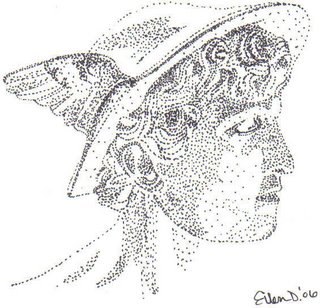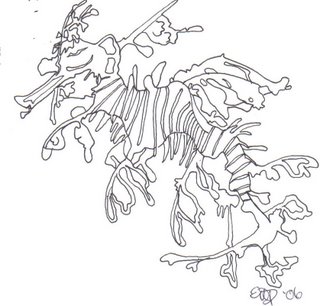
Mercury/Hermes- Speed.Illustration Friday
Of course this was my first idea but I assumed it would be thought of by everyone so I didn't post it originally. Four years in Latin class and my favourite part was the Gods and Goddesses!!! (The teacher was really cool too...thank you Miss Johnson wherever you are!!)
O.K. sooooo here is an interesting tidbit. Did you know the names of Mercury's famous helmet, shoes and magic staff? Me neither. The winged sandals were called "talarius," and were a symbol of his swiftness. His winged hat was called "petasus," a traveler's hat. It's symbolism was the same as the talarius, but it additionally became the symbol of inspiration, because as psychopomp, he was likewise the guide of the mystic. His herald's staff??? The "caduceus," was a magic wand that could change lead into gold and cure any; therefore it became the symbol of modern medicine!


Sea Dragon- Speed.I'm sure you are waiting with "baited breath" as to my explaination of what the heck a Sea Dragon (Sea Horse) has to do with speed, right?! Well I live near the sea and the word "speed" got me to wondering how fast the dolphins travel up and down the shore every morning and evening (37mph on the waves of a ship's bow and 28mph on open water). When I ended up looking at a list of the fastest fish in the sea. (Sailfish 68.18mph, Mako Shark 60mph, Marlin 50mph, Wahoo 48.5mph, Bluefin Tuna 43.4mph, Blue Shark 43mph, Bonefish 40mph and Swordfish 40mph! Guess that explains the price difference between Mako Shark and Swordfish at my favourite resteraunt! LOL!) OK...so the slowest fish????? You guessed it! Believe it or not the sea horse travels a whopping 0.01mph!!!!
More info on Sea Dragons.....
Sea Dragons are arguably the most spectacular and mysterious of all ocean fish. Though close relatives of sea horses, sea dragons have larger bodies and leaf-like appendages which enable them to hide among floating seaweed or kelp beds. Sea dragons feed on larval fishes and amphipods, such as and small shrimp-like crustaceans called mysids ("sea lice"), sucking up their prey in their small mouths. Many of these amphipods feed on the red algae that thrives in the shade of the kelp forests where the sea dragons live.
As with their smaller common seahorse (and pipefish) cousins, the male sea dragon carries and incubates the eggs until they hatch. During mating the female deposits up to 250 eggs onto the "brood patch" on the underside of the male's tail. After about eight weeks, the brood hatches, but in nature only about 5 per cent of sea dragons survive to maturity (two years). A fully grown Leafy Sea Dragon grows to about 18 inches (45 cm).
Leafy Sea Dragons are very interesting to watch-- the leafy appendages are not used for movement. The body of a sea dragon scarcely appears to move at all. Steering and turning is through movement of tiny, translucent fins along the sides of the head (pectoral fins, visible above) and propulsion derives from the dorsal fins (along the spine). Their movement is as though an invisible hand were helping, causing them to glide and tumble in peculiar but graceful patterns in slow-motion. This movement appears to mimic the swaying movements of the seaweed and kelp. Only close observation reveals movement of an eye or tiny fins.

